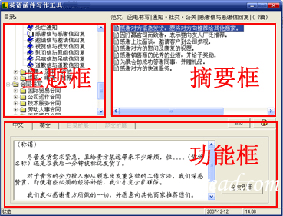英文法律词典 A-64
|
ADMISSIONS, in evidence. Concessions by a party of the existence of certain facts. The term admission is usually applied to civil transactions, and to matters of fact in criminal cases, where there is no criminal intent the term confession, (q. v.) is generally considered as an admission of guilt. 2. An admission is the testimony which the party admitting bears to the truth of a fact against himself. It is a voluntary act,which he acknowledges as true the fact in dispute. [An admission and consent are, in fact, one and the same thing, unless indeed for more exactness we say, that consent is given to a present fact or agreement, and admission has reference to au agreement or a fact anterior for properly speaking, it is not the admission which forms a contract, obligation or engagement, against the party admitting. The admission is, by its nature, only the proof of a pre-existing obligation, resulting from the agreement or the fact, the truth of which is acknowledged. There is still another remarkable difference between admission and consent: the first is always free in its origin, the latter, always morally forced. I may refuse to consent to a proposition made to me, abstain from a fact or an action which would subject me to an obligation ; but once my consent is given, or the action committed, I am no longer at liberty to deny or refuse either; I am constrained to admit, under the penalty of dishonor and infamy. But notwithstanding all these differences, admission is identified with consent, and they are both the manifestation of the will. These admissions are generally evidence of those facts, when the admissions themselves are proved.] 3. The admissibility and effect of evidence of this description will be considered generally, with respect to the nature and manner, of the admission itself and, secondly, with respect to the parties to be affected by it. 4. In the first place, as to the nature and manner of the admission; it is either made with a view to evidence; or, with a view to induce others to act upon the representation; or, it is an unconnected or casual representation. 5. – 1. As an instance of admission made with a view to evidence may be mentioned the case where a party has solemnly admitted a fact under his hand and seal, in which case he is, estopped, not only from disputing the deed itself, but every fact which it recites. B. N. P. 298; 1 Salk. 186; Com. Dig. Estoppel, B 5; Stark. Ev. pt. 4, p. 3 1. 6. – 2. Instances of thing second class of admissions which have induced others to act upon them are those where a man has cohabited with a woman, and treated her in the front of the world as his wife, 2 Esp. 637; or where he. has held himself out to the world in a particular character; Ib. 1 Camp. 245; he cannot in the one case deny her to be his Wife when sued by a creditor who has supplied her with goods as such, nor in the other can he divest himself of the character be has assumed. 7. – 3. Where the admission or declaration is not direct to the question pending, although admissible, it is not in general conclusive evidence; and though a party may by falsifying his former declaration, show that he has acted illegally andimmorally, yet if he is not guilty of any breach of good faith in the existing transaction, and has not induced others, to act upon his admission or declaration, nor derived any benefit from it against his adversary, be is not bound by it. The evidence in such cases is merely presumptive, and liable to be rebutted. 8. Secondly, with respect to the parties to be affected by it. 1. By a party to a suit, 1 Phil. Ev. 74; 7 T. R. 563; 1 Dall. 65. The admissions of the party really interested, although he is no party to the suit, are evidence. 1 Wils. 257. 9. – 2. The admissions of a partner during the existence of a partnership, are evidence against both. 1 Taunt. 104; Peake's C. 203 1 Stark. C. 81. See 10 Johns. R. 66 Ib. 216; 1 M. & Selw. 249. As to admissions made after the dissolution. of the partnership, see 3 Johns. R. 536; 15 Johns. R. 424 1 Marsh. (Kentucky) R. 189. According to the English decisions, it seems, the admissions of one partner, after the dissolution, have been holden to bind the other partner; this rule has been partially changed by act of parliament. Colly. on Part. 282; Stat. 9 Geo. IV. c. 14, (May 9, 1828.) In the Supreme Court of the United States, a rule, the reverse of the English, has been adopted, mainly on the ground, that the admission is a new contract or promise, springing out of, ana supported by the original consideration. 1 Pet. R. 351; 2 M'Lean, 87. The state courts have varied in their decisions some have adopted the English rule; and, in others it has been overruled. 2 Bouv. Inst. ii. 1517; Story, Partn. 324; 3 Kent, Com. Lect. 43, p. 49, 4th ed.; 17 S. & R. 126; 15 Johns. R. 409; 9 Cowen, R. 422; 4 Paige, R. 17; 11 Pick. R. 400; 7 Yerg. R. 534. 10. – 3. By one of several persons who have a community of interest. Stark, Ev. pt. 4, p. 47; 3 Serg. & R. 9. 11. – 4. By an agent, 1 Phil. Ev. 77-82 3 Paley Ag. 203-207. 12. – 5. By an attorney, 4 Camp. 133; by wife, Paley, Ag. 139, n. 2 Whart. Dig. tit. Evidence, 0 7 T. R. 112 ; Nott & M'C. 374. 13. Admissions are express or implied. An express admission is one made in direct terms. An admission may be implied from the silence of the party, and may be presumed. As for instance, when the existence of the debt, or of the particular right, has been asserted in his presence, and he has not contradicted it. And an aquiescence and endurance, when acts are done by another, which if wrongfully done, are encroachments, and call for resistance and opposition, are evidence, as a tacit admission that such acts could not be legally resisted. See 2 Stark. C. 471. See, generally, Stark. Ev. part 4, tit. Admissions; 1 Phil. Ev. part 1, c. 5, s . 4; 1 Greenl. Ev. 169-212; 2 Evans' Pothier, 319; 8 East, 549, ii. 1; Com. Dig. Testemoigne, Addenda, vol. 7, p. 434; Vin. Abr. Evidence, A, b. 2, A, b. 23 Ib. Confessions; this Dict. tit. Confessions, Examination; Bac. Abr. Evidence L.; Toullier, Droit, Civil Francais, tome 10, p. 375, 450; 3 Bouv. Inst. n. 3073. |








